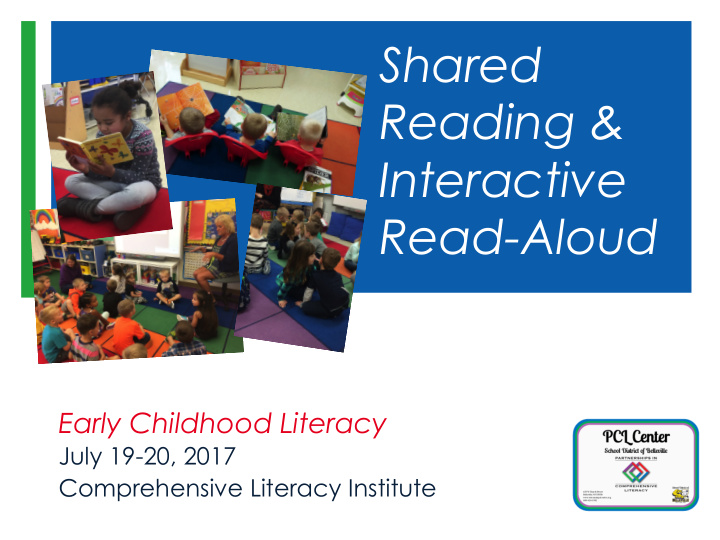



Shared Reading & Interactive Read-Aloud Early Childhood Literacy July 19-20, 2017 Comprehensive Literacy Institute
Who we are? v Marsha v Kelsey v Tammy
Outcomes ¡ Understand components of 4K Shared Reading ¡ Understand components of 4K Interactive Read Aloud ¡ Identify the differences for instructional purposes and planning ¡ Opportunity for planning
Agenda ¡ Inclusion ¡ Schedules ¡ Shared Reading ¡ Interactive Read Aloud ¡ Collaboration Time ¡ Wrap Up
Logistics ¡ Movement throughout the presentation ¡ Preview our learning folder ¡ Venn Diagram for Note-taking throughout session ¡ Parking Lot…a place for questions
Key Principles in Early Learning Connectedness Intentionality Standards
Key Components in Early Learning Connectedness, Intentionality, Standards Lan Language guage Interactive Read Shared Reading Interactive Aloud Writing
Inclusion -- AAE ü Look for index card in folder ü Find all those in the room with same colored dot ü Introduce yourself o Your name o Where you teach o Your role in education
Inclusion -- AAE ü Together determine what your common acronym stands for ü Name 1 positive and 1 negative in your experience with this acronym.
Aligning 4K with PCL Model Integrated Workshop Model Scientific Knowledge and Research Skills Content Writing Process Workshop Craft and Conventions Deep Writing Reading Comprehension Workshop Workshop Language Listening and Workshop Speaking Comprehension Language Dorn, L. & Jones, 2012. Apprenticeship in Literacy, Foundation 2 nd Ed. Stenhouse
Look-Fors
Schedules 4K Kindergarten
Shared Reading ¡ Read – quiet reading (5 min) ¡ Literacy Beginnings—Pgs 125-130 ¡ AIL—Pgs 36-37 ¡ Share with elbow partner ¡ How would you define Shared Rdg? ¡ What characteristic(s) were most notable?
Shared Reading ¡ Definition: A “lap story” reading experience that supports oral language comprehension, vocabulary learning, and print knowledge while using large, clear print text that provides opportunity for children to join in the reading and begin to see themselves as readers.
Shared Reading ¡ Key Characteristics: ¡ Fun text, but also supports teaching point! ¡ Enlarged text with clear print for all to see easily ¡ Predictable story lines, limited lines of text, and repeated lines of print that may include rhyme or rhythm ¡ Daily instruction with repeated readings and modeling for how print works ¡ Can be any genre! ¡ Lesson Planner (blank)
Shared Reading ¡ Video— What Can We Share (Kelsey) ¡ Review Kelsey’s lesson planner ¡ Can use Shared Reading Look-Fors to identify components of the lesson ¡ Table Share – what did you see?
Interactive Read Aloud ¡ Read – quiet reading (7 min) ¡ Literacy Beginnings—Pgs 114 -124 ¡ AIL—Pg 35 ¡ Share with … table partners u How would you define Interactive Read Aloud? u What characteristic(s) were most notable?
Interactive Read Aloud ¡ Definition: An opportunity for children to hear our language through a variety of genres, to develop a love of books, to build background knowledge and vocabulary, and to have rich, meaningful conversations about these interesting texts/books.
Interactive Read Aloud ¡ Key Characteristics: ¡ Opportunity for students to hear language of books; to hear a variety genres, text structures, vocabulary, & new concepts (literacy & content) ¡ To be actively engaged in learning—listening, making connections, and discussion of texts ¡ Interactive read aloud routines—sitting, responding during reading, turn & talks ¡ Clear illustrations so all can see ¡ Day 1 reading is always about comprehension ¡ Lesson Planner (blank)
Interactive Read Aloud ¡ Video— Kiss the Cow (Kelsey) ¡ Review Kelsey’s lesson planner ¡ Use Look-Fors to identify components of the lesson ¡ Table Share – what did you see?
Shared Reading and Interactive Read Aloud ¡ Pulling it all together ¡ Choo Choo Clickety Clack ¡ Review Lesson Planners (Interactive/Shared) ¡ Video—Shared Reading— (Marsha)
Work Time: ¡ What to do… ¡ Schedule ¡ Favorite resource to create interactive read aloud ¡ Favorite resource to create shared reading ¡ Intentional team-planning
Conclusion ¡ Thank you so much for your attention and participation!! ¡ EXIT SLIP
Resources Used Today ¡ What Can We Share by Brenda Parks, Benchmark Education, 2014. ¡ Kiss the Cow by Phyllis Root, Candlewick, 2003. ¡ Choo Choo Clickty Clack by Margaret Mayo, Lerner Books, 2005. ¡ Literacy Beginnings by Pinnell & Fountas, Heinemann, 2011. ¡ Apprenticeship In Literacy by Dorn & Jones, Stenhouse Publishers, 2012.
Contact Information for Presenters ² Kelsey Schmit ² Email: schmitk@belleville.k12.wi.us ² Marsha Rear ² Email: rearm@belleville.k12.wi.us ² Facebook: ² www.facebook.com/belleville/intermediate ² Represents both Elementary & Intermediate school. ² Tammy Boyd ² Email: tlcboyd.education@gmail.com
Contact Information ¡ Email: Michelle Amend michelle@wisconsinpclcenter.org ¡ Website: http://www.wisconsinpclcenter.org ¡ Facebook: https://www.facebook.com/ WisconsinPCLCenter/
Recommend
More recommend